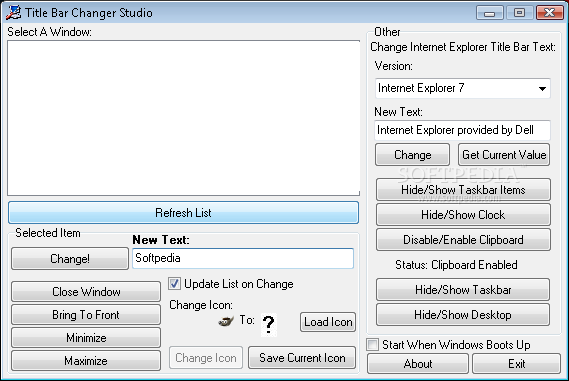

- PERMANENT TITLE BAR CHANGER INSTALL
- PERMANENT TITLE BAR CHANGER SOFTWARE
- PERMANENT TITLE BAR CHANGER CODE
Troubleshooting Mouse not working properly in VimĪdd set ttymouse=sgr and set mouse=a to your. See the hints: section of alacritty.yml for configuration details. When activated, the matched texts are highlighted with "hints" according to the configured alphabet and presented to the user for selection via keyboard.īy default, Alacritty provides hinting URLs via the Ctrl+Shift+U shortcut and opens them with xdg-open. Regex hints can be used to find text in the visible part of the terminal and pipe it to other applications. To copy/paste to/from X clipboard, you can use a mouse selection to copy and a middle mouse click to paste. To copy, you can either use a mouse to select and press Ctrl+Shift+c, or enter Vi mode, start a selection using v, move around with hjkl like in vim, and copy the selection with y. By default you can toggle it using Ctrl+Shift+Space. The vi mode allows moving around Alacritty's viewport and scrollback using the keyboard. Then edit the line xterm*|rxvt*|Eterm|aterm|kterm|gnome*) to add alacritty* so that it reads xterm*|rxvt*|Eterm|alacritty*|aterm|kterm|gnome*). Tips and tricks Spawn new instance in same directoryĪdd the following lines to your configuration file to spawn a new instance of Alacritty in the current working directory by pressing Ctrl+Shift+Enter: Note that some fonts do not provide an Italic style but an Oblique style instead.

Substitute monospace with a font name from the output of If you do not want to use your system’s default font, you can specify a different font by changing the following lines:
PERMANENT TITLE BAR CHANGER CODE
If your preferred color scheme is on the list, paste the provided code into your configuration file. See the upstream wiki for a list of available color schemes. Most settings take effect as soon as you save the file. $XDG_CONFIG_HOME/alacritty/alacritty.ymlĬopy the example configuration file at /usr/share/doc/alacritty/example/alacritty.yml to one of those places and uncomment the settings you want to change.
PERMANENT TITLE BAR CHANGER INSTALL
Install the alacritty package or alacritty-git AUR for the development version.Īlacritty searches for a configuration file at the following places in this order: 4.6 Different font size on multiple monitors.4.4 Requires hardware supporting GLSL 3.30.4.3 Terminal functionality unavailable in remote shells.3.1 Spawn new instance in same directory.On top of that, its price seems too much when taking into account its limited set of features. This way, you might be tricked into thinking that the tool is not, in fact, working. The only inconvenience here is that there is no other way of bringing back its configuration panel on the screen after clicking the "Start" button, unless you've remembered the key combination. To sum it up, Permanent Title Bar Changer offers a simple solution to editing the title bars of any running programs.

It had minimal impact on computer performance, running on low CPU and RAM.
PERMANENT TITLE BAR CHANGER SOFTWARE
No error dialogs popped up in our tests, and the software program didn't hang or crash. Worth noting is that it's not necessary for a window to be active when writing its old and new title, since the changes are retained by the system and carried out automatically when the window in question becomes active. You can switch to its main window only by triggering the right key combination (Alt + Shift + F9). It's possible to add as many entries as you want to the list, change their order, as well as to enable or disable case sensitive mode.Īll modifications are committed with the click of a button, and the the title bars remain changed for as long as Permanent Title Bar Changer is running. Easily edit window title barsĪll you have to do is write the old text of a title bar, along with the new one you want to replace it with. As far the interface is concerned, Permanent Title Bar Changer adopts a small window with a plain appearance and neatly organized structure, which has a global keyboard shortcut assigned for bringing it up on the screen seamlessly, regardless of the environment you're currently working in. The setup procedure is a fast and easy job. The tool doesn't implement complicated options or customization preferences, making it accessible to all types of users. You can use it to personalize commonly accessed applications, for example. Permanent Title Bar Changer is an easy-to-use program that, as the name implies, gives you the possibility to edit the title bar of your active windows.


 0 kommentar(er)
0 kommentar(er)
